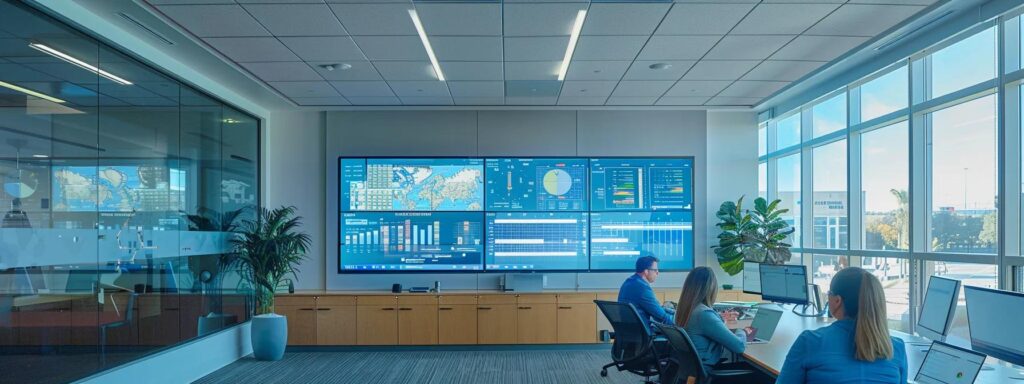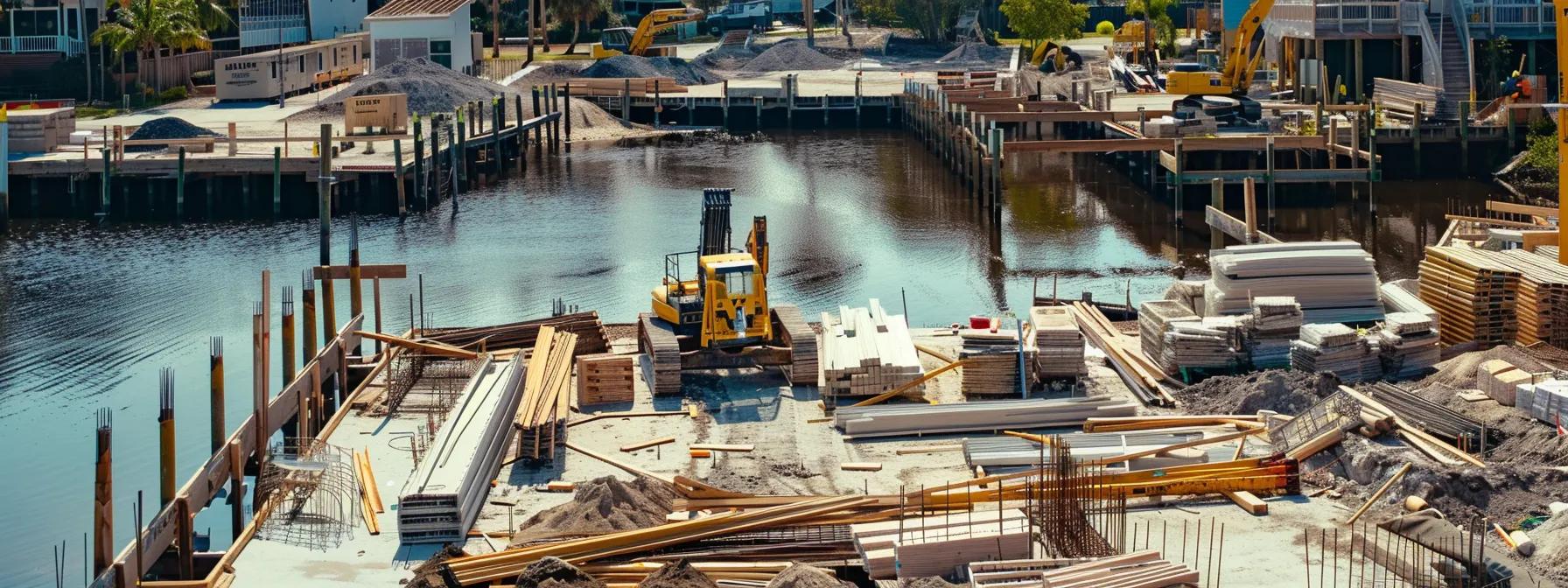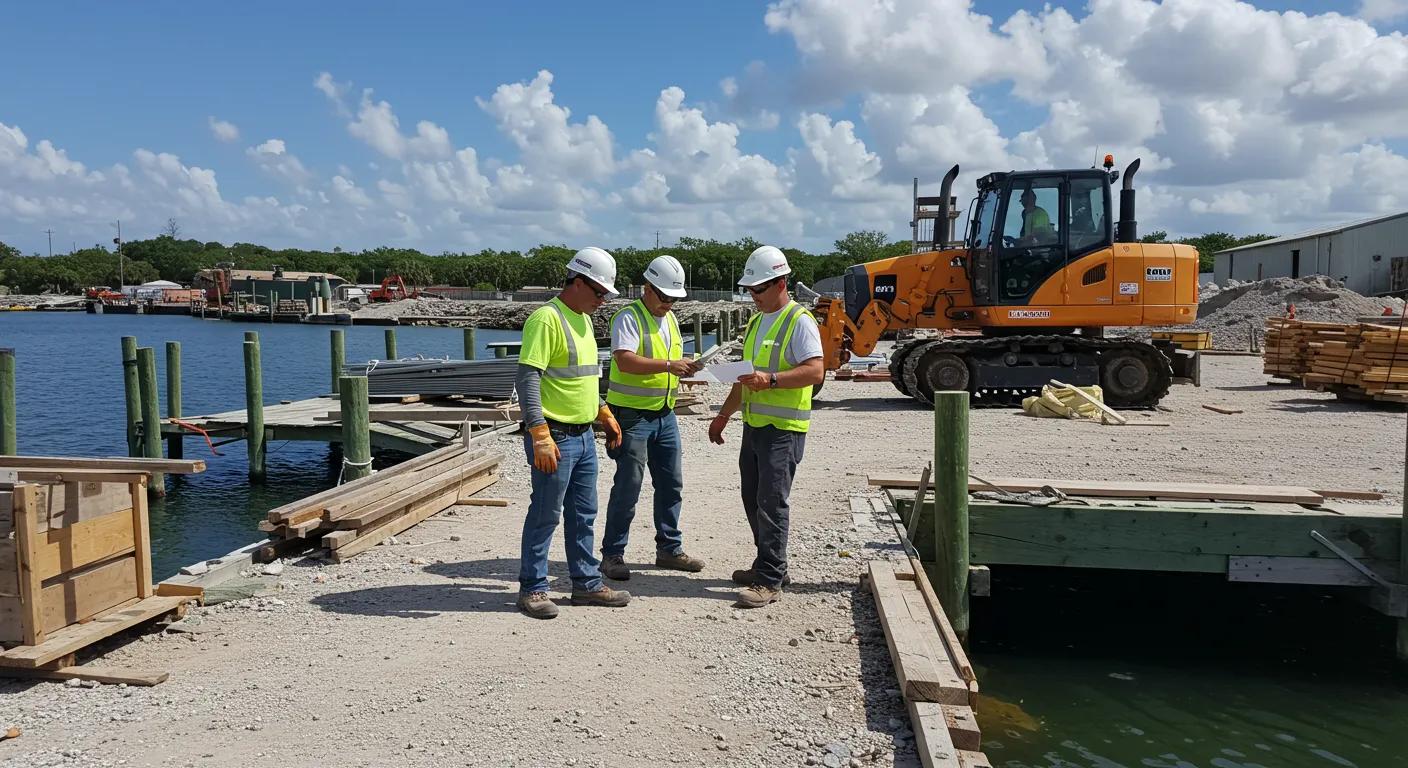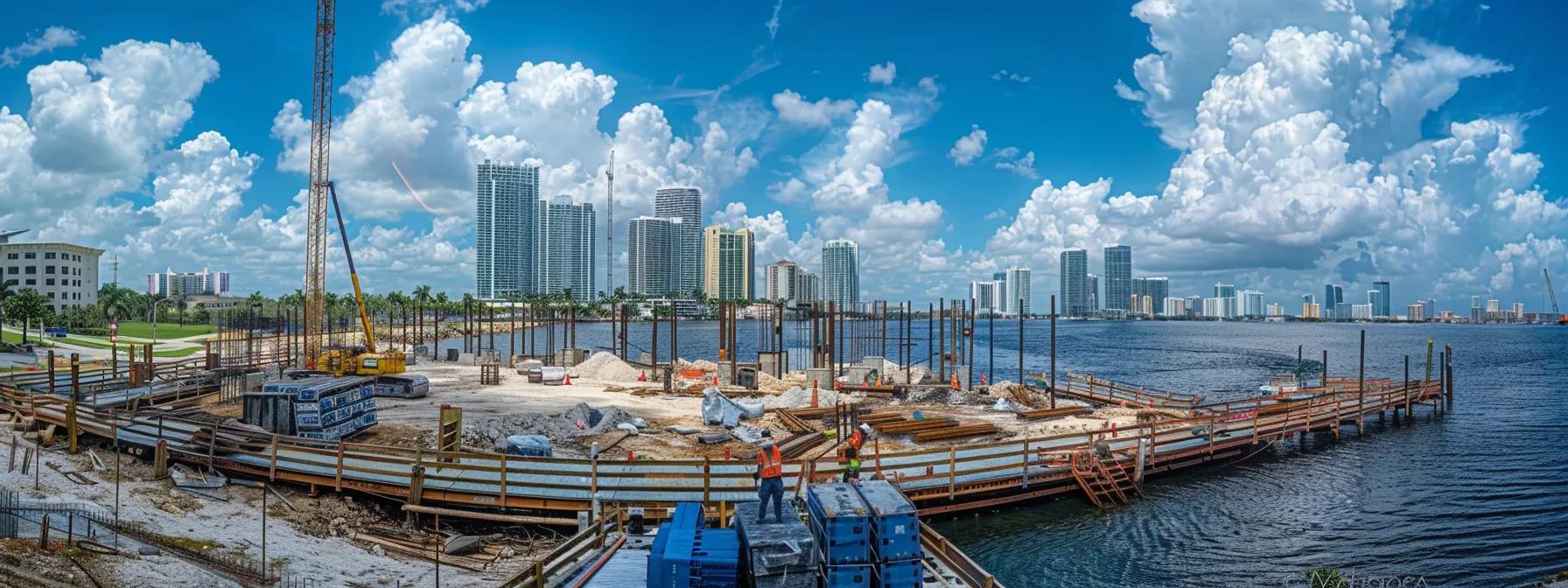Key Steps for Successful Budgeting and Scheduling in Dock Construction Endeavors
In the complex world of dockconstruction, effective budgeting and scheduling are key to project success. Every dollar must be accounted for and each construction phase carefully planned. This article will help you navigate dockconstruction budgeting and scheduling by breaking down cost factors, outlining strategies for a comprehensive schedule, and describing methods for tracking both budget and progress. In this guide, you will find actionable tips, risk assessment methods, and best practices for resource allocation that ensure efficiency, regulatory compliance, and sustainable outcomes. Let’s explore how to optimize every aspect of a dockconstruction project from budgeting and scheduling to final reviews.
Understand Key Components of Dock Construction Budgeting
Successful dockconstruction begins with understanding the critical cost components that form your overall budget. It is essential to break down every expense element to produce a realistic, comprehensive estimate.
Identify Cost Factors for Dock Construction Projects
Start by outlining every potential expense, including materials, labor, equipment, and other fees. Direct costs (concrete, steel, timber, specialized dock materials) and indirect costs (site preparation and environmental testing) must both be considered. For example, obtaining multiple supplier quotes can reduce material costs by up to 15% compared to standard pricing. This detailed breakdown prepares you for unexpected expenses and helps prevent budget overruns.
Analyze Material and Labor Expenses
Material and labor costs form a large part of the construction budget. Materials like treated wood, reinforced concrete, and marine-grade components significantly impact expenses, while labor rates can vary based on region, union rules, and project complexity. Analyzing these expenses in detail enables you to plan procurement schedules so that materials and skilled labor—such as welders and crane operators—are available when needed.
Factor in Permitting and Regulatory Requirements
Dock projects face stringent permitting and regulatory requirements. Budgeting for environmental permits, zoning approvals, and safety inspections (typically 5% to 10% of the overall cost) is essential. Early factoring of these fees not only avoids legal issues but also ensures the dock meets required environmental and structural standards, reducing the risk of delays.
Include Contingency Budgets for Unexpected Costs
Even with detailed planning, unforeseen issues such as adverse site conditions or sudden price increases can occur. Setting aside a contingency fund (typically 10% to 20% of your total budget) provides vital financial flexibility. This reserve lets you address emergencies without compromising overall project objectives.
Utilize Software Tools for Budget Tracking
Modern project management software can transform budget tracking by allowing real-time updates, linking cost estimates with project timelines, and generating detailed financial reports. This technology enhances accuracy, fosters transparency, and minimizes manual errors in budgeting, ensuring that every outlay is monitored against set project milestones.
Develop a Comprehensive Dock Construction Schedule

Creating a detailed construction schedule is as crucial as budgeting. A well-structured schedule clearly defines every phase of the dockconstruction process and aligns each task with the overall timeline.
Outline Major Phases of Dock Construction Work
Break the project into distinct phases such as site analysis, design, permitting, procurement, construction, and final inspections. Clearly defining these phases ensures that all stakeholders understand the project’s progression. For example, the design phase might involve several weeks of structural planning before moving into a multi-month construction phase. This clear outline helps avoid scope creep and supports timely decision-making across disciplines.
Allocate Timeframes for Each Construction Activity
Assign realistic timeframes to activities like foundation pouring, setting support pilings, and installing dock surfaces. Accurate time allocation, based on historical data and industry benchmarks, prevents delays and ensures labor and materials are synchronized with project needs. Coordinating these schedules with material deliveries and labor shifts enhances overall efficiency.
Incorporate Weather and Environmental Considerations
Weather and environmental factors often cause delays. Incorporate buffers into your schedule for adverse conditions like rain or high winds, and consider restrictions related to water management and habitat protection. Proactively planning for these factors helps mitigate risks and demonstrates regulatory compliance.
Set Milestones for Project Progress Monitoring
Milestones serve as critical checkpoints that allow you to monitor progress and ensure key deliverables are met. Establishing targets for tasks like foundation completion or final inspections provides measurable goals and facilitates transparent communication with stakeholders. Regular milestone reviews can identify issues early, ensuring the project remains on track.
Adjust Schedules Based on Real-Time Feedback
Once construction begins, schedules must be flexible. Real-time feedback—whether due to unexpected site conditions or material delivery delays—requires quick adjustments. Using project management software to update timelines instantly ensures that all team members work with the latest information and helps prevent cascading delays.
Implement Effective Tracking Methods for Budget and Schedule
With a comprehensive budget and schedule in place, effective tracking is essential to keep the project on target.
Use Project Management Software for Real-Time Updates
Integrate project management software to obtain real-time data on budget expenditures and scheduling progress. These tools consolidate information from invoices, labor logs, and equipment reports into one dashboard, allowing you to quickly compare planned figures to actual costs. Linking cost data directly to schedule milestones generates a transparent, digitized tracking system that minimizes human error.
Establish Regular Check-Ins for Budget and Timeline
Regular team meetings—whether weekly or bi-weekly—create a backbone for effective tracking. In these sessions, review financial reports and timeline charts to identify discrepancies from the plan. Open discussions on potential risk areas and mitigation strategies foster collective responsibility and allow for timely adjustments.
Review and Adjust Tasks Based on Project Performance
Continuous review is key. Analyze each task’s performance and adjust plans accordingly. If certain tasks face recurring delays, assess whether additional resources or process improvements are needed. Regular performance reviews keep lines of accountability clear and ensure that both the budget and schedule remain aligned with project goals.
Communicate With Stakeholders About Changes
Maintaining transparent communication with all stakeholders is critical. Whenever the budget or schedule is adjusted, explain the reasons and corrective actions taken. Detailed reporting on cost variances and timeline adjustments helps reduce ambiguity and builds trust throughout the project lifecycle.
Keep Detailed Records of All Financial Transactions
Accurate record-keeping supports internal reviews and external audits. Every financial transaction—from invoice payments to material purchases—should be meticulously documented. Digital systems that integrate with your project management software reduce manual errors and provide an invaluable audit trail, ensuring ongoing regulatory compliance.
Identify Risks and Mitigation Strategies for Dock Projects

Every construction project has inherent risks, and proactive planning is crucial to mitigate them.
Assess Potential Risks in Dock Construction Planning
Perform a comprehensive risk assessment before beginning construction. Identify potential issues such as challenging site conditions, weather disruptions, supply chain delays, and labor shortages. For example, unstable soil conditions can delay the project and elevate costs. Quantify risk levels, estimate financial impacts, and prioritize hazards to set the stage for effective contingency planning.
Create Contingency Plans for Budget Overruns
Budget overruns are common in construction, so well-structured contingency plans are essential. Develop measures to address unexpected expenses or market changes, such as sudden material price spikes. Pre-planned fund reallocations from less critical areas can help cover unforeseen costs while keeping the overall project scope intact.
Evaluate Scheduling Conflicts and Delays
Identify potential scheduling conflicts early by continuously comparing the planned timeline with real-time performance data. Delays caused by material delivery issues, labor disruptions, or weather should prompt immediate adjustments through task rescheduling or resource reallocation. This proactive management prevents minor setbacks from developing into major delays.
Develop Strategies to Address Environmental Challenges
Environmental challenges—like tidal changes, water contamination, or soil erosion—must be addressed with specialized strategies. Mitigation measures might include creating environmental buffer zones, using reinforced materials for elevated water levels, or installing extra drainage systems. Such targeted strategies ensure that the project remains both environmentally friendly and compliant with regulations.
Monitor Risks Throughout the Project Lifecycle
Risk management extends from planning to project completion. Regular audits and updates of the risk management plan, along with an up-to-date risk register, allow you to track known risks and quickly address any new issues. Continuous monitoring with agile response strategies ensures the project adapts to challenges as they arise.
Optimize Resource Allocation for Dock Construction Success
Efficient resource allocation is essential to maximize productivity and minimize waste throughout the construction process.
Manage Workforce Resources Efficiently
Effective workforce management means scheduling skilled labor only when needed and avoiding overburdening your team. Use workforce management software to align labor shifts with specific project milestones, such as concrete pouring or dock installation. Collaborate closely with subcontractors and ensure clear communication to maintain both high morale and productivity.
Plan Material Delivery to Avoid Delays
Timely material delivery is critical; delays can disrupt the entire project schedule. Coordinate closely with suppliers and plan logistics so that deliveries coincide with construction phases. In some cases, setting up alternative supplier agreements provides a backup plan if supply chain issues occur.
Coordinate Equipment Use for Maximum Productivity
Dockconstruction relies on heavy equipment, such as cranes and excavators. Implement an equipment scheduling system to track usage and maintenance, ensuring that all machinery is available as needed and operated efficiently. Proper coordination reduces downtime and minimizes the risk of costly equipment failures.
Engage With Subcontractors for Specialized Work
When specialized skills are needed—whether for marine engineering, environmental compliance, or complex carpentry—engage with experienced subcontractors. Verify their certifications and track records to ensure quality. Clear communication and defined terms with subcontractors integrate their expertise smoothly into the overall project.
Monitor Resource Use to Minimize Waste
Monitoring material usage through digital inventory systems and regular audits helps control waste and costs. Comparing planned versus actual usage and using predictive analytics supports continuous improvement and ensures that all resources are used as efficiently as possible.
Review and Refine Budget and Schedule Post-Project

After project completion, a thorough review of budgeting and scheduling practices solidifies lessons learned and enhances future projects.
Analyze Budget Performance After Project Completion
Conduct a detailed financial review immediately after project completion. Compare original estimates to actual expenditures to identify any variances and determine if issues arose from unforeseen circumstances or planning miscalculations. This review not only reveals cost-saving opportunities but also improves future budgeting accuracy.
Evaluate Schedule Efficiency and Time Management
Assess the overall project timeline by comparing planned versus actual completion times for each phase. Determine which factors—such as material supply issues or labor shortages—contributed to any delays. This evaluation helps refine scheduling approaches, buffer time allocations, and timeline estimates for future projects.
Gather Feedback From Team and Stakeholders
Feedback from project team members and key stakeholders is essential. Honest evaluations of both budgeting and scheduling practices help build a knowledge base that promotes organizational learning. This feedback loop is vital for refining workflow protocols and communication strategies.
Document Lessons Learned for Future Projects
Systematically document insights gained throughout the project in a “lessons learned” report. Highlight challenges faced, successful mitigation strategies, and areas for improvement. This documentation builds institutional memory and reinforces best practices for future dockconstruction projects.
Adjust Planning Techniques for Continuous Improvement
Use the lessons learned to adjust planning and execution techniques for subsequent projects. Whether by updating project management software, refining contingency budgets, or enhancing communication protocols, continuous improvement ensures that your projects remain efficient, responsive to industry changes, and aligned with evolving cost structures.
Final Thoughts
Mastering budgeting and scheduling in dockconstruction requires detailed planning, continuous monitoring, and adaptive strategies. Every phase—from initial cost assessments and delivery coordination to post-project analysis—plays a vital role in meeting your project goals. By integrating advanced project management tools with regular stakeholder communication, you can ensure transparency and efficiency throughout the construction process. Embrace these strategies to streamline your planning processes and secure successful outcomes on all future dockconstruction endeavors.
Frequently Asked Questions
Q: How can I accurately estimate costs for dockconstruction? A: Begin by identifying all cost factors such as materials, labor, permits, and environmental fees. Collect multiple supplier quotes and use project management software to link budget elements with your construction timeline. This structured approach minimizes surprises during the project.
Q: What strategies can help manage unexpected expenses? A: Include a contingency budget ranging from 10% to 20% of the total project cost. Regular financial reviews and real-time tracking using construction management software enable prompt fund reallocation to address unplanned expenses.
Q: How do environmental factors affect dockconstructionschedules? A: Environmental conditions, including high winds and tidal changes, can delay projects. Incorporate buffer days into your timeline and adjust work schedules based on weather forecasts to minimize disruptions.
Q: What are the benefits of using project managementsoftware in dockconstruction? A: Software tools offer real-time budget and schedule updates, consolidate data from multiple sources, and support regular stakeholder communication. They promote transparency and facilitate prompt adjustments, enhancing overall efficiency.
Q: How can I ensure that resourceallocation is optimized throughout the project? A: Detailed scheduling of workforce, material deliveries, and equipment usage—supported by regular audits and tracking systems—helps monitor resource use and prevents waste. Clear deadlines and collaboration with experienced subcontractors further maximize productivity.
Q: Why is post-project review important for future dockconstruction projects? A: A thorough review of budget performance and scheduling efficiency, combined with team feedback, identifies successful strategies and improvement areas. Documenting these lessons enhances the accuracy of future projects.
Q: How do I maintain stakeholder communication during unforeseen project changes? A: Establish regular check-in meetings and use real-time dashboards to communicate changes. Transparent reporting on budget variances, schedule adjustments, and risk mitigation efforts ensures stakeholders remain informed and aligned throughout the project lifecycle.




